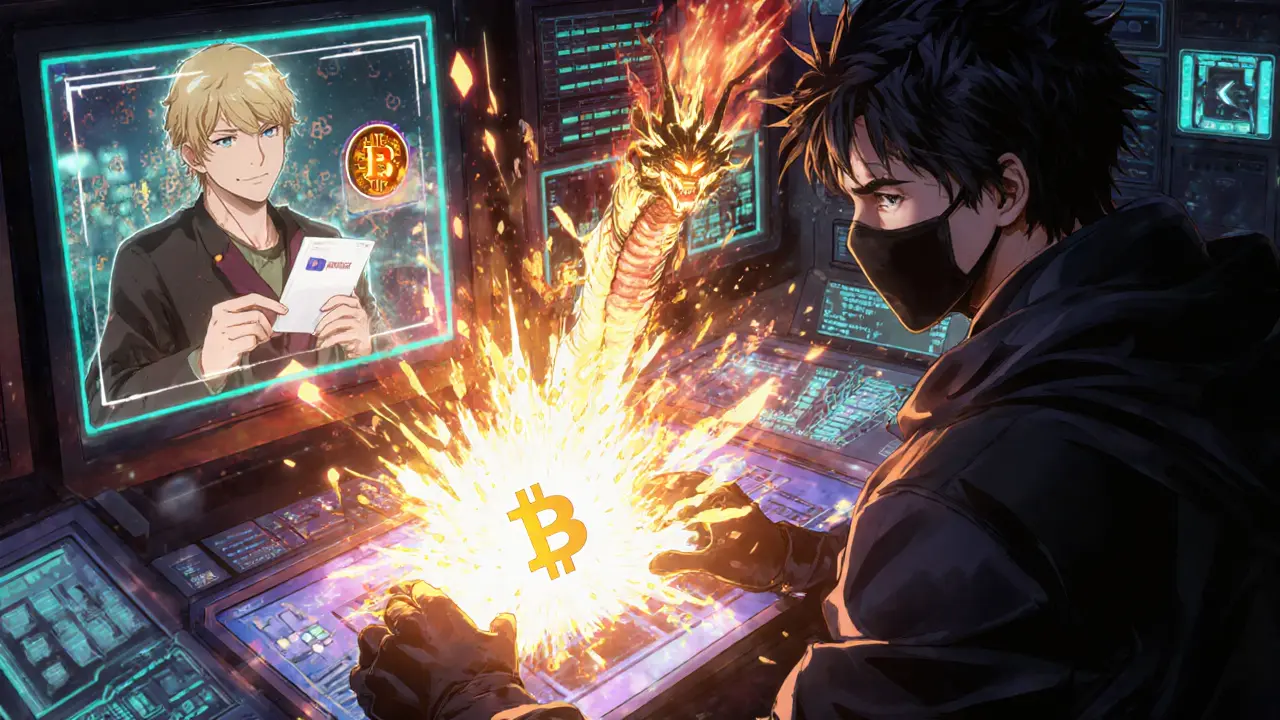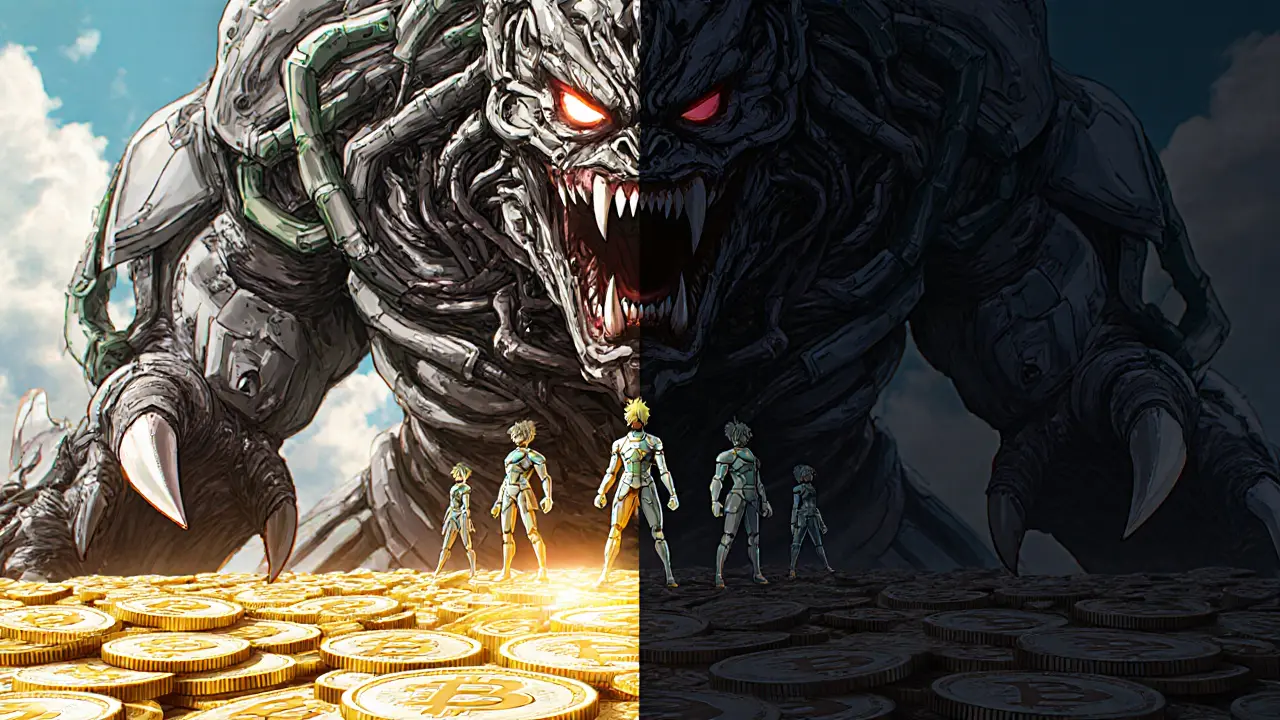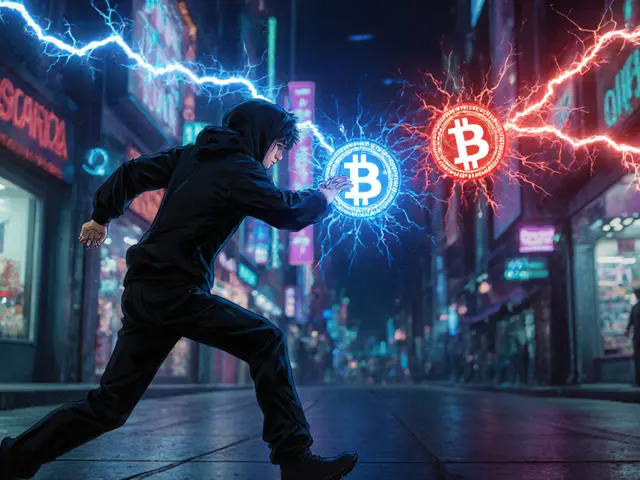Bitcoin Confirmation Calculator
How Many Confirmations Do You Need?
The Bitcoin network requires multiple confirmations to prevent double-spending attacks. This calculator helps you determine the right number of confirmations based on your transaction value.
Recommended Confirmations
According to industry standards:
- 1 confirmation: Suitable for small purchases under $100
- 3 confirmations: Recommended for purchases between $100-$1,000
- 6 confirmations: Required for high-value transactions over $1,000
Imagine paying for coffee with Bitcoin, and the same coins get spent again-right after you’ve already received your drink. That’s a double-spending attack. It sounds impossible, right? But in the early days of digital cash, it was the biggest roadblock to making cryptocurrency real money. Bitcoin solved it. But hackers keep trying. And they’re not always failing.
Why Double-Spending Is a Big Deal
Physical cash can’t be copied. If you hand someone a $20 bill, you no longer have it. Digital money? It’s just data. A file. And files can be duplicated. Without a system to stop it, you could send the same Bitcoin to ten people at once. Suddenly, the whole idea of scarcity breaks. The currency loses value. People stop trusting it. Bitcoin’s blockchain fixed this by making every transaction public, permanent, and verified by thousands of computers worldwide. But no system is perfect. Attackers look for gaps-tiny delays, weak networks, or flawed rules-and exploit them. Understanding how they do it is the first step to staying safe.The Race Attack: Speed Over Proof
This is the simplest and most common double-spending trick. Here’s how it works:- An attacker sends the same Bitcoin to two different recipients at the same time.
- One transaction goes to a merchant (say, for a laptop).
- The other goes to another wallet the attacker controls.
- They hope the merchant’s node sees the fake transaction first, confirms it, and ships the product.
- Meanwhile, the real transaction (the one going back to the attacker) gets confirmed by the main blockchain.
The Finney Attack: Pre-Mining the Bet
This one’s sneakier. It requires the attacker to be a miner-or have access to mining power. Here’s the step-by-step:- The attacker mines a block in secret. Inside that block is a transaction sending coins to themselves.
- They then spend the same coins in a public transaction-say, buying something from a merchant.
- Once the merchant accepts the transaction (often without waiting for confirmations), the attacker releases their pre-mined block.
- If their block gets added to the chain before the merchant’s transaction, the merchant’s transaction gets rejected. The attacker keeps the goods and the coins.

The 51% Attack: Taking Over the Network
This is the nuclear option. If someone controls more than half of a blockchain’s total computing power, they can rewrite history. Here’s what that looks like:- The attacker mines a chain in secret that includes a double-spend transaction.
- They wait until a transaction (say, buying cryptocurrency on an exchange) is confirmed on the public chain.
- Then they release their longer, secret chain-overwriting the original.
- The exchange now sees the double-spend as the real transaction and refunds the attacker’s coins.
How Centralized Systems Handle It (And Why They’re Not the Answer)
Before Bitcoin, digital money relied on banks or payment processors to track who owns what. PayPal, Venmo, or even your bank’s app-all of them prevent double-spending by checking your balance in real time. If you try to send $100 twice, the system blocks the second one. But here’s the catch: you have to trust them. If PayPal gets hacked? Your money’s gone. If they freeze your account? You can’t access your cash. If they make a mistake? You’re stuck waiting for a customer service rep. Blockchain removes that middleman. But it doesn’t remove risk-it just changes it. Instead of trusting a company, you trust math, code, and economics. That’s why the focus isn’t on eliminating double-spending entirely-it’s on making attacks so hard and expensive that they’re not worth trying.
How to Protect Yourself
If you’re buying or selling crypto, here’s what you need to do:- Wait for confirmations. One confirmation is okay for small purchases. For anything over $1,000, wait for six.
- Use payment processors. Services like BitPay or Coinbase Commerce automatically wait for confirmations and flag suspicious transactions.
- Don’t rush. If someone pressures you to “send now or lose the deal,” that’s a red flag.
- Check the network. If a coin’s hash rate has dropped recently, be extra cautious. Smaller networks are more vulnerable.
What’s Next? Quantum, Stake, and New Defenses
The future of double-spending defense is evolving. Proof-of-stake blockchains like Ethereum don’t rely on mining power-they rely on staked tokens. To attack, you’d need to own over 51% of all the coins in circulation. That’s even harder than owning 51% of the hash power. Plus, if you try to cheat, you lose your entire stake. Layer-2 solutions like the Lightning Network handle payments off-chain, then settle them on Bitcoin. They use smart contracts to lock funds and prevent double-spending without waiting for blockchain confirmations. But they’re still new. If you’re using them, know the risks. And then there’s quantum computing. Someday, a quantum computer might break the cryptographic signatures used in Bitcoin. That’s a long way off-but researchers are already working on quantum-resistant algorithms. The goal? Make sure the next generation of crypto can’t be hacked by machines we haven’t built yet.Double-Spending Isn’t Dead-It’s Just Harder
The first double-spending attack was theoretical. Now, it’s a real threat-especially on weak networks. But Bitcoin? It’s stood strong. Its massive network, economic incentives, and six-confirmation rule make attacks pointless. The lesson? Don’t fear the attack. Fear the complacency. If you’re treating crypto like cash and not checking confirmations, you’re playing Russian roulette. But if you understand how these attacks work-and take simple steps to defend against them-you’re not just safe. You’re ahead of most people using crypto today.Can you double-spend Bitcoin successfully today?
It’s nearly impossible on Bitcoin’s main network. The hash rate is too high, and the cost of a 51% attack exceeds $10 billion. Most attempts fail before they start. However, smaller altcoins with low hash rates have been successfully attacked multiple times since 2018.
How many confirmations are safe for a Bitcoin transaction?
For small purchases under $100, one confirmation is usually fine. For purchases between $100 and $1,000, three confirmations are recommended. For anything over $1,000, always wait for six confirmations. Each confirmation adds another block on top, making reversal exponentially harder.
What’s the difference between a race attack and a 51% attack?
A race attack exploits network delays and doesn’t require mining power-it’s about timing. A 51% attack requires controlling more than half of the network’s computing power and lets you rewrite the blockchain history. The first is easy to prevent with confirmations; the second requires a massive, expensive infrastructure.
Can you get your money back after a double-spending attack?
Once a transaction is confirmed and overwritten by a longer chain, there’s no way to reverse it. The blockchain is immutable. Your only recourse is legal action against the attacker-if you can identify them. That’s why prevention (waiting for confirmations) is far better than recovery.
Are exchanges safe from double-spending attacks?
Most major exchanges like Coinbase and Binance are safe because they require multiple confirmations before crediting deposits. They also monitor for suspicious activity. But smaller exchanges, especially those using less secure blockchains, have been hacked via double-spending. Always check an exchange’s security practices before depositing funds.









Comments (16)
Cody Leach
November 13, 2025 AT 15:25 PMOne confirmation is fine for coffee, but never for a laptop. I've seen people get burned because they trusted a quick tx. Wait for six. It's not that hard.
sandeep honey
November 14, 2025 AT 03:33 AMWhy do people still think 51% attacks are rare? Look at Ethereum Classic. They got hammered for $5M. It's not about Bitcoin. It's about the weak chains getting picked off like fish in a barrel. Stop acting like the whole crypto world is safe.
Mandy Hunt
November 15, 2025 AT 00:18 AMThey're lying about the 51% cost. The government already has quantum computers. They're not telling us. The real attack isn't from hackers-it's from the Fed secretly rewriting blockchains to control your money. They don't need mining rigs. They need silence.
anthony silva
November 16, 2025 AT 07:01 AMWait for six confirmations? Wow. What a revolutionary idea. Next you'll tell me to wear pants when leaving the house. Thanks for the life advice, blockchain grandma.
David Cameron
November 17, 2025 AT 04:50 AMIt's not about the tech. It's about trust. We used to trust banks. Then we trusted code. Now we're trusting economics. But what if the economy itself is the exploit? The real double-spend is trusting anything at all.
Sara Lindsey
November 18, 2025 AT 19:49 PMSTOP WAITING AND START LIVING! If you're overthinking confirmations you're missing out on the future! Crypto is speed! Speed! Speed! Trust the process and go hard or go home!!
alex piner
November 19, 2025 AT 05:47 AMMan i used to think this was all too complicated but now i get it. Just wait for a few blocks and youll be fine. Thanks for breaking it down easy like this. Really helped me feel less lost.
Gavin Jones
November 20, 2025 AT 06:31 AMOne must acknowledge the elegance of the blockchain's design: a distributed consensus mechanism that, despite its computational intensity, achieves a form of digital trust unattainable through centralized authority. It is not perfect, yet it is profoundly innovative.
Mauricio Picirillo
November 20, 2025 AT 11:21 AMFor real though, if you're buying something online with crypto, just use BitPay. They handle all the confirmations and flag sketchy stuff. You don't need to be a nerd to stay safe. Just use the tools.
Liz Watson
November 21, 2025 AT 20:47 PMOh wow, six confirmations? How quaint. I guess you're also still using rotary phones and writing letters to your mom. Meanwhile, I'm on Lightning Network, settling payments in 0.3 seconds. Your ‘security’ is just slow.
Rachel Anderson
November 22, 2025 AT 11:10 AMI just cried reading about the Finney attack. It's so beautiful and terrifying. Like a silent assassin in the code. My soul trembles every time I send BTC. Is anyone else this emotionally connected to blockchain?
Hamish Britton
November 23, 2025 AT 14:44 PMMost people don't realize the race attack is basically a timing glitch. It's not magic. Just bad habits. If you're not waiting for at least one block, you're asking for trouble. Simple as that.
Robert Astel
November 24, 2025 AT 09:51 AMSo like, I was thinking, what if the real double spend isn't the transaction but the idea of ownership itself? Like, if I send you a bitcoin, am I really giving you something, or just shifting a label on a ledger? And if the ledger is just a bunch of computers agreeing on a story... then what's real? I mean, like, isn't everything just a consensus? Like, my dog thinks I'm the king of the couch. Is that different? I think we're all just nodes in a giant emotional blockchain now.
Andrew Parker
November 25, 2025 AT 03:06 AMMy heart broke when I read about Ethereum Classic. I cried for 3 hours. I felt like I lost a friend. The blockchain is alive. It feels pain. And when they double-spend, it screams. I know this because I dreamt it. The code whispered to me. I'm not crazy. I'm just awakened.
Kevin Hayes
November 25, 2025 AT 04:50 AMWhile the economic disincentives of 51% attacks on Bitcoin are well-documented, the theoretical vulnerability persists. The assumption that cost exceeds benefit is contingent on market stability and predictable hash rate growth. Should either falter, the system's integrity becomes contingent on social consensus, not cryptographic certainty.
Katherine Wagner
November 26, 2025 AT 16:19 PMWait for six confirmations??? But what if you dont want to wait??? Why do people think security is more important than speed??? Like why is this even a debate??? Its just a number on a screen!!!